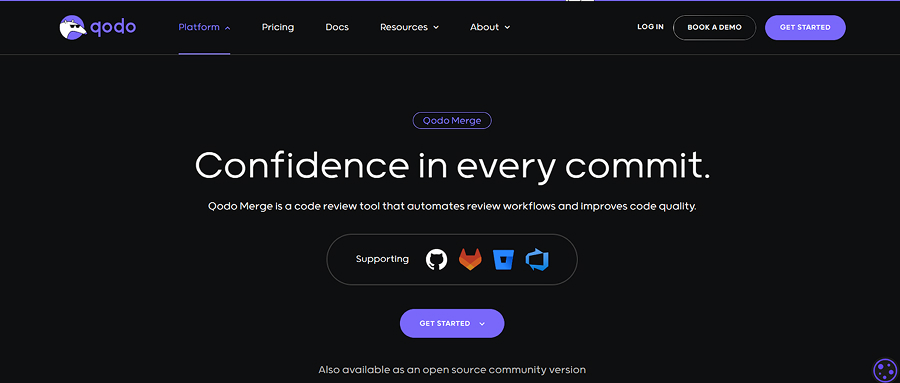9 Best Automated Code Review Tools for Developers in 2025
TL;DR
- Manual reviews slow teams down – overloaded reviewers and scattered workflows create bottlenecks.
- AI tools now assist with reviews, offering intelligent, context-aware feedback beyond linting or formatting.
- Qodo Merge uses RAG for adding context aware code suggestions, that is critical for larger teams and enterprises.
- The right tool improves code quality, review speed, and developer morale – not just productivity.
- This post breaks down 9 top tools (Qodo Merge, Greptile, CodeRabbit, Codacy, DeepSource, and more) with real dev use cases.
- Ideal for teams looking to scale reviews, reduce bugs, and boost code integrity-especially in fast-moving or distributed teams.
Code reviews aren’t broken, but the way most teams handle them slows everything down.
As a technical lead, I’ve seen teams move fast in sprints, hit engineering goals, and still lose momentum just because code reviews take too long. The problem isn’t always bad code or unclear requirements. More often, it’s something else: code reviewers juggling multiple responsibilities, too many pull requests waiting for attention, and not enough time to go through them properly.
GitLab’s survey backs this up. After long work hours and context switching, code review delays are the third biggest reason developers feel burned out. And honestly, that makes sense. No one likes feeling blocked or ignored. That’s why automated code reviews are a game changer.
Automated code review is a process of using software tools to automatically scan and evaluate source code for issues related to syntax, security and violation of code standards. These tools plug into CI/CD pipelines to deliver instant feedback, ensure consistency, and lighten the load on human reviewers.
Especially with large feature PRs going to production, manual reviews are helpful. But it’s easy to miss a detail or two, which can lead to hidden vulnerabilities that slip through the testing phase. Code review tools really help teams to not only accelerate but also move with precision and find hidden bugs before they cause any debts in the future.
If you’re trying to improve how your team handles reviews – not just speed, but actual code quality and developer experience – I will help you figure out what works and what doesn’t. I’ll walk through which tools help, which don’t, and what to look for if you’re trying to make code reviews smoother without cutting corners. Let’s get into it.
Choosing the Best Automated Code Review Tools for Your Workflow
Selecting the right automated code review tool isn’t about picking the one with the most features or the slickest UI. It comes down to how well the tool supports the team’s day-to-day workflow, especially under real-world conditions like tight deadlines, large PRs, and distributed teams.
Based on practical usage across varied engineering environments, these six criteria consistently determine whether a tool adds value or just adds noise:
Setup Time and Learning Curve
A review tool should integrate into the workflow with minimal setup and zero hand-holding. If onboarding takes longer than half an hour or requires formal training, adoption tends to drop quickly.
Accuracy of Review Comments
Tools that surface irrelevant or low-priority suggestions often become background noise. Effective review tools highlight critical issues, not cosmetic changes or redundant linter feedback.
Team Collaboration Features
Features like threaded comments, reviewer assignment, and custom workflows help reduce back-and-forth. A good review system clarifies ownership, supports asynchronous feedback, and makes follow-up easy.
CI/CD or GitHub Integration
Clean integration with GitHub or GitLab, along with visibility into CI status, helps maintain momentum. Whether it’s merge blocking, status checks, or automated tagging, these integrations should work without manual intervention.
AI Reliability (for AI Tools)
AI-based tools must provide insight beyond formatting or syntax. The best ones act like an experienced reviewer, flagging logic gaps, inconsistent behavior, or potential edge-case failures.
Support for Security and Code Quality Standards
Enterprise and high-compliance teams often rely on OWASP, SAST tools, or internal secure coding rules. A proper review tool should support these checks natively or integrate with tools that do.
Teams that evaluate review tools against these criteria tend to see fewer missed issues, tighter feedback loops, and faster approvals without cutting corners. Don’t just go for tools that promise quick results.
Pick something that actually helps you improve code quality, not just when you’re coding, but also when you’re testing and reviewing it later.
Let’s first look at how AI-assisted tools are transforming the code review process. These tools go beyond formatting checks and help developers catch logic flaws, flag inconsistencies, and reduce the stress of code review, especially when used alongside human reviewers.
Context Matters More Than You Think
One thing I’ve learned while exploring AI code review tools is that syntax isn’t everything. A tool might suggest code that’s technically correct, but if it doesn’t align with the way we structure our code, our naming conventions, logic flows, or architectural choices, it creates more noise than value. That’s especially true when you’re working at scale or in an enterprise setting where consistency really matters.
What stood out to me about Qodo Merge is how well it adapts to the actual context of your codebase. It uses RAG (Retrieval-Augmented Generation) to adapt to your codebase. So, instead of just relying on pre-trained models; it understands what’s already in your repo.
That means the suggestions feel more relevant, the patterns more familiar, and the overall experience more grounded in reality. It’s the kind of context awareness that saves time, reduces bugs, and helps new developers get up to speed faster without constantly second-guessing the AI.
9 Best Automated Code Review Tools
AI-Automated Code Review Tools
Now that we’ve broken down the key factors to consider when choosing a code review tool, it’s time to look at the options that actually make a difference in practice.
As codebases scale and teams grow, manual code reviews can slow things down or miss subtle bugs. AI-assisted tools close that gap. They don’t just check syntax, they analyze patterns, flag deeper issues, and suggest cleanups that align with your team’s practices. Here’s a look at the ones that are actually pulling weight in real-world CI/CD pipelines.
1. Qodo Merge
Qodo Merge takes the top spot for me when it comes to AI-powered code merging. The reason why I put this in the first place is because of its insane code integrity along with speed and convenience. This tool doesn’t just resolve merge conflicts, it ensures that every change made to the codebase maintains high standards of quality.
I really was impressed with how it goes beyond just spotting the differences between branches. It understands the entire context, including sibling modules, dependencies, and historical patterns in the codebase. I’ve found this especially useful when merging large features from multiple developers.
Where Qodo Merge Really Helped Me
When I was working on a real-time analytics platform for an IoT project, I used Qodo Merge to keep code quality intact during a complex merge.
Our team ran into overlapping updates across a shared utility module. Typical Git merges would’ve turned it into a mess, conflicting function logic, naming conventions, and inconsistent docstrings.
Prompt: “Merge and resolve conflicts in a real-time data processing module, ensuring efficient error handling, logging, and integration with a NoSQL database.”
Qodo Merge handled it perfectly. It:
- Recognized semantic-level conflicts that Git just sees as line diffs.
- Merged logic changes smartly, preserving intent from all sides.
- Even unified the docstrings without wiping anyone’s documentation.
Qodo Merge doesn’t just fix issues, it guides you to write production-ready systems that are both scalable and maintainable. For me, it meant fewer Slack threads about “who overwrote what,” and more time shipping features.
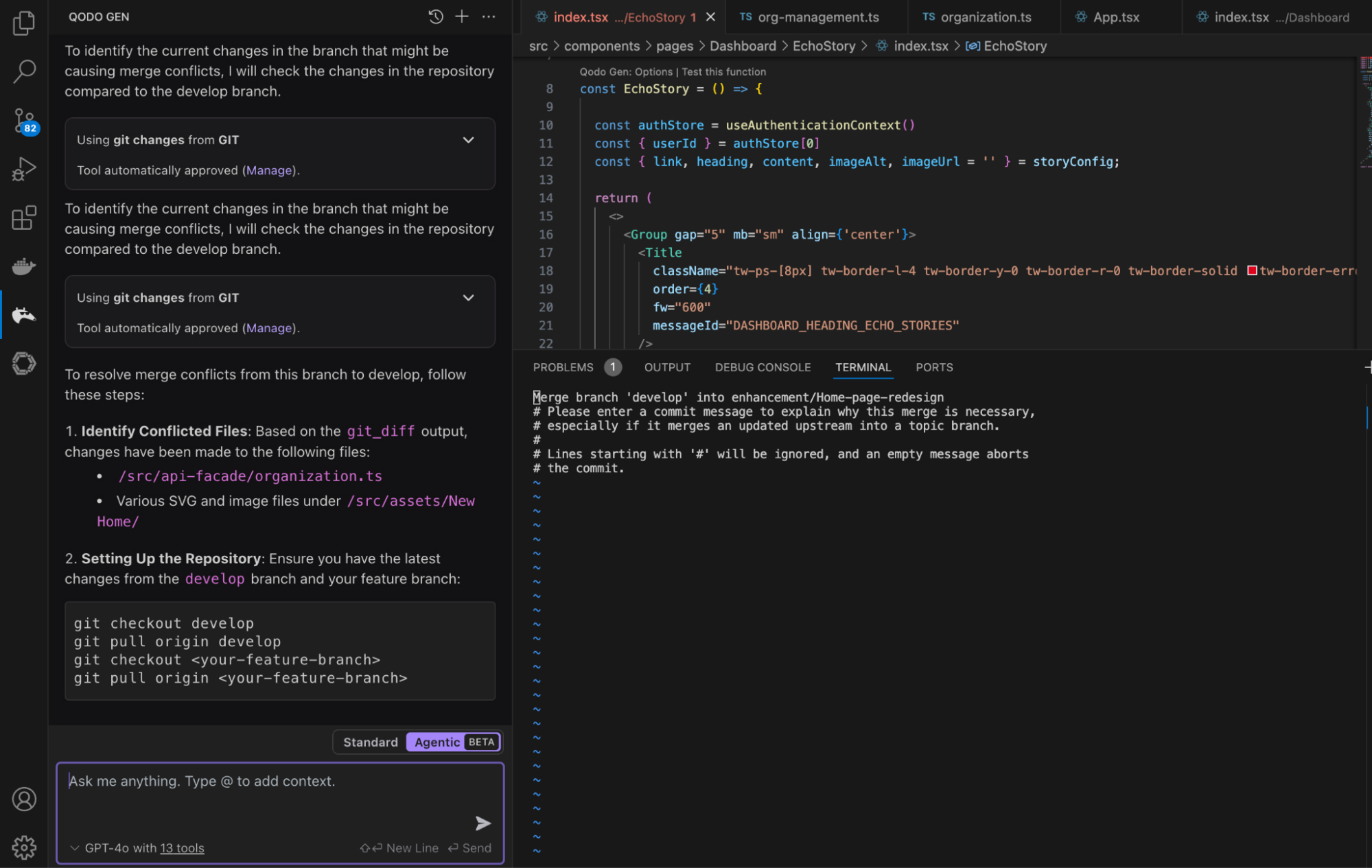
Pros
- Context-aware merging: Saves hours of manual conflict resolution by understanding the full context, not just the diffs.
- Architectural consistency: Uses architectural standards across large teams, reducing the risk of inconsistent code practices.
- Real-time feedback: Continuous evaluation of code quality after every contribution ensures long-term maintainability.
Cons
- Learning curve: The advanced features may take some time to master, especially for new users.
- Plugin ecosystem: While it covers major platforms, its plugin ecosystem is still expanding and may not support all use cases.
Pricing:
Free for individuals and open-source contributors. Team plan available at $15/user/month, offering advanced review tools and integrations suitable for teams managing frequent code changes.
2. Greptile
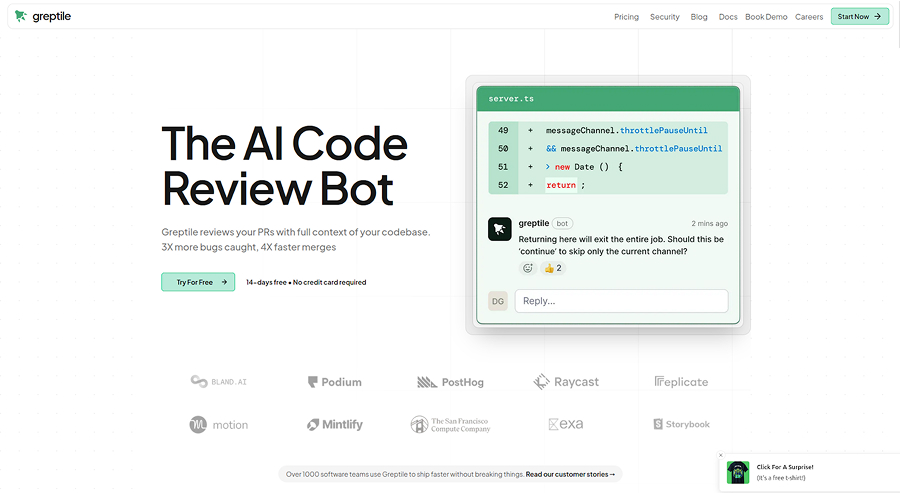
Next, using Greptile felt like a co-reviewer that never missed any context. Instead of looking at just the diff, it scans the full codebase to understand dependencies and usage patterns. Unlike traditional code review tools that just flag syntax issues, Greptile analyzes the full impact of changes, offering natural-language summaries and pinpointing high-risk areas in your code.
I really appreciate how it uses natural language summarises and highlights risky code changes in PRs. Plus, the tool claims that it learns from your repo over time, becoming more aligned with your engineering standards.
My Experience with Greptile:
I was once reviewing a pull request that changed the behavior of an “add” function in a critical service, without updating its name or description. While the code seemed harmless at first glance, it had the potential to break the functionality downstream by misrepresenting the operation. Greptile flagged this immediately.
Prompt: “Review a PR that changes a basic arithmetic function, ensuring it follows expected naming conventions and performs correctly.”
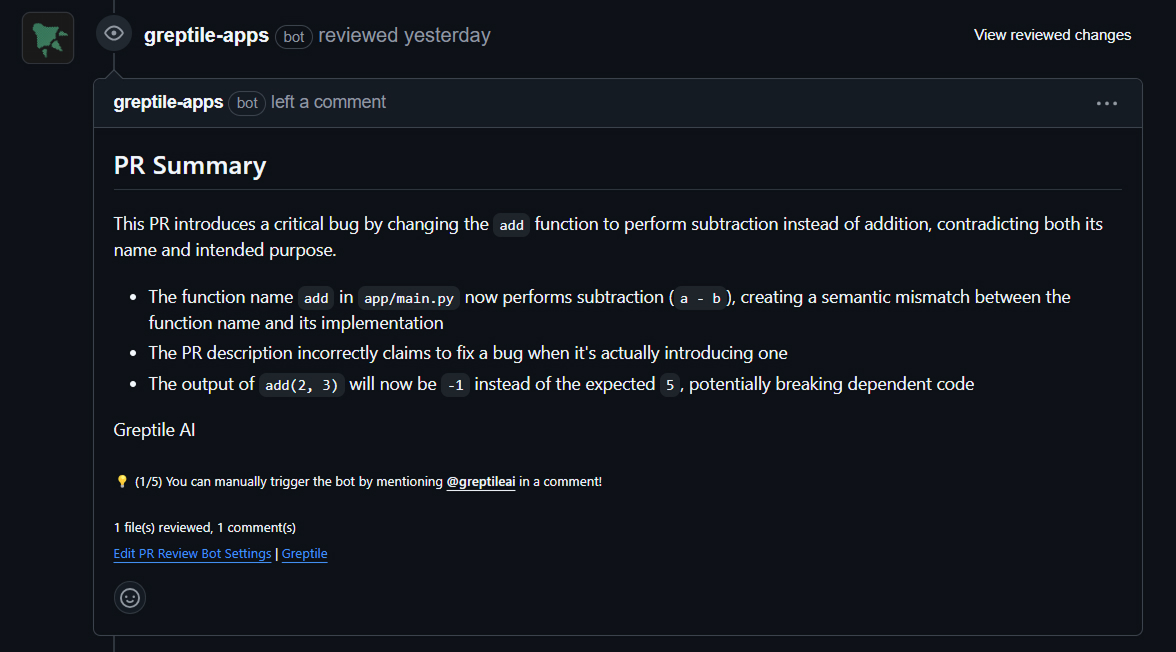
Greptile was able to highlight the issue and the function originally intended to perform addition now performed subtraction while keeping its name as “add”. It explained how this change could break the logic across services that expected the original behavior. The bot explains the functional impact clearly: add(2, 3) will now return -1 instead of 5, which could silently break downstream logic that expects standard addition.
Pros
- Natural language feedback: Provides clear, concise explanations for each flagged issue, making it easy for developers to act on them immediately.
- Self-learning: The more it interacts with your repo, the smarter it gets, adapting to your team’s unique coding standards and practices.
Cons
- Initial setup for large repos: For teams with large, complex monorepos, there might be a learning curve during the initial configuration phase.
- Overreliance on context: Sometimes, Greptile’s feedback could be too specific to your codebase, which may need additional manual checks for certain edge cases.
Pricing
Greptile offers a free trial, with paid plans starting at $0.45/file up to $50/dev/mo. Custom pricing is available for larger teams or self-hosted enterprise setups.
3. CodeRabbit
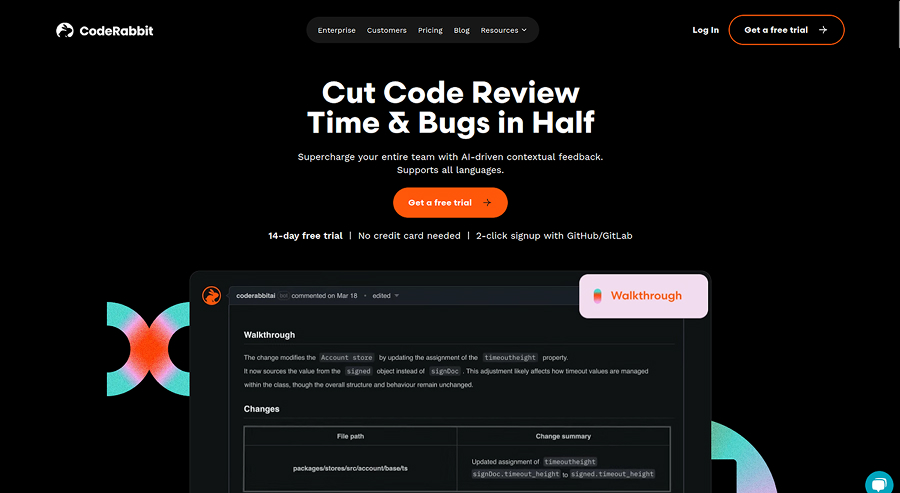
CodeRabbit catches code issues directly within GitHub or GitLab pull requests, and it does so almost instantly. One feature I particularly love is how it catches simple issues that might easily be overlooked during manual reviews.
For example, I recently worked on a PR where a function was called add, but it actually performed subtraction (a-b). This naming mismatch could have caused confusion for anyone using the function later on, but CodeRabbit flagged it right away.
My Experience with CodeRabbit:
In this case, CodeRabbit didn’t just point out that the function name didn’t match its logic, it actually suggested how to fix it. I could either update the function to do addition again or rename it to fit what it was doing now.
What really helped was the inline code snippet showing exactly what the change should look like. It even reminded me to update any dependent code if I went with the rename, which really showed how well it understood the bigger picture. The feedback was super clear and detailed, as it should be.
Additionally, CodeRabbit reminds developers to update all dependent code if the function name is changed, showing awareness of downstream impact.
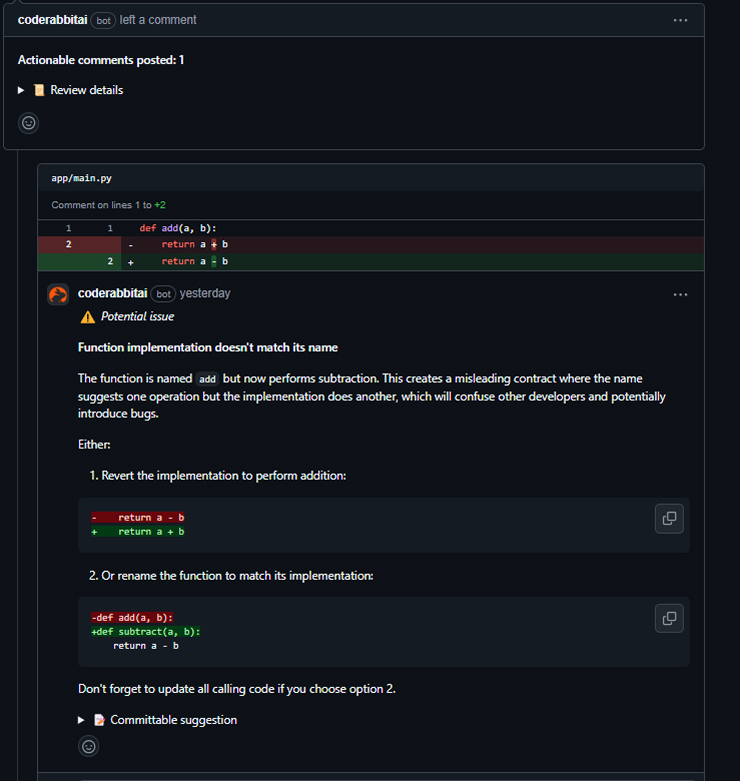
Pros
- Actionable, contextual feedback: CodeRabbit goes beyond just pointing out issues; it provides clear solutions with inline code examples.
- Ideal for onboarding: It helps junior developers learn as they work, teaching them best practices directly within the PR.
Cons
- Limited to GitHub/GitLab: CodeRabbit is designed specifically for these platforms, which could be a downside for teams using others.
- Can seem basic for advanced users: For seasoned developers, some feedback may feel elementary, as it targets a broad audience.
Pricing
Offers a free plan for individuals and smaller teams, with paid Pro plan starting at $24/month for advanced features, team collaboration, and additional integrations.
4. Codacy
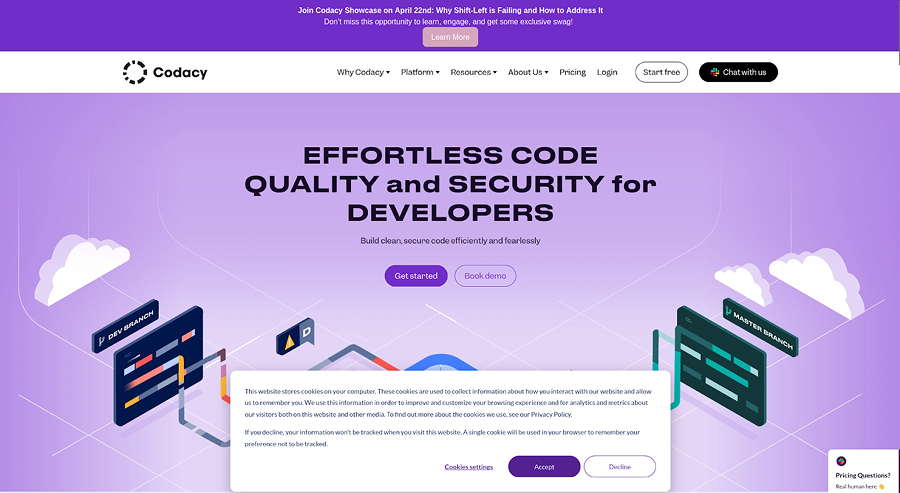
Codacy is a static code analysis tool that I’ve come to rely on for maintaining deep, consistent quality in codebases. What I appreciate most about Codacy is its ability to automate checks across various code quality dimensions: style, complexity, duplication, test coverage, and potential bugs.
It really found it helpful that it integrates seamlessly with platforms like GitHub and GitLab, evaluating code on every commit and offering real-time feedback that helps maintain high-quality standards.
My Experience with Codacy
Let’s get to an example to show how Codacy helped me. I recently worked with Codacy on a test PR, and it didn’t disappoint. It ran a quality check and flagged one issue, offering quick access to detailed logs, diffs, and categorized reports (e.g., Issues, Duplication, Complexity).
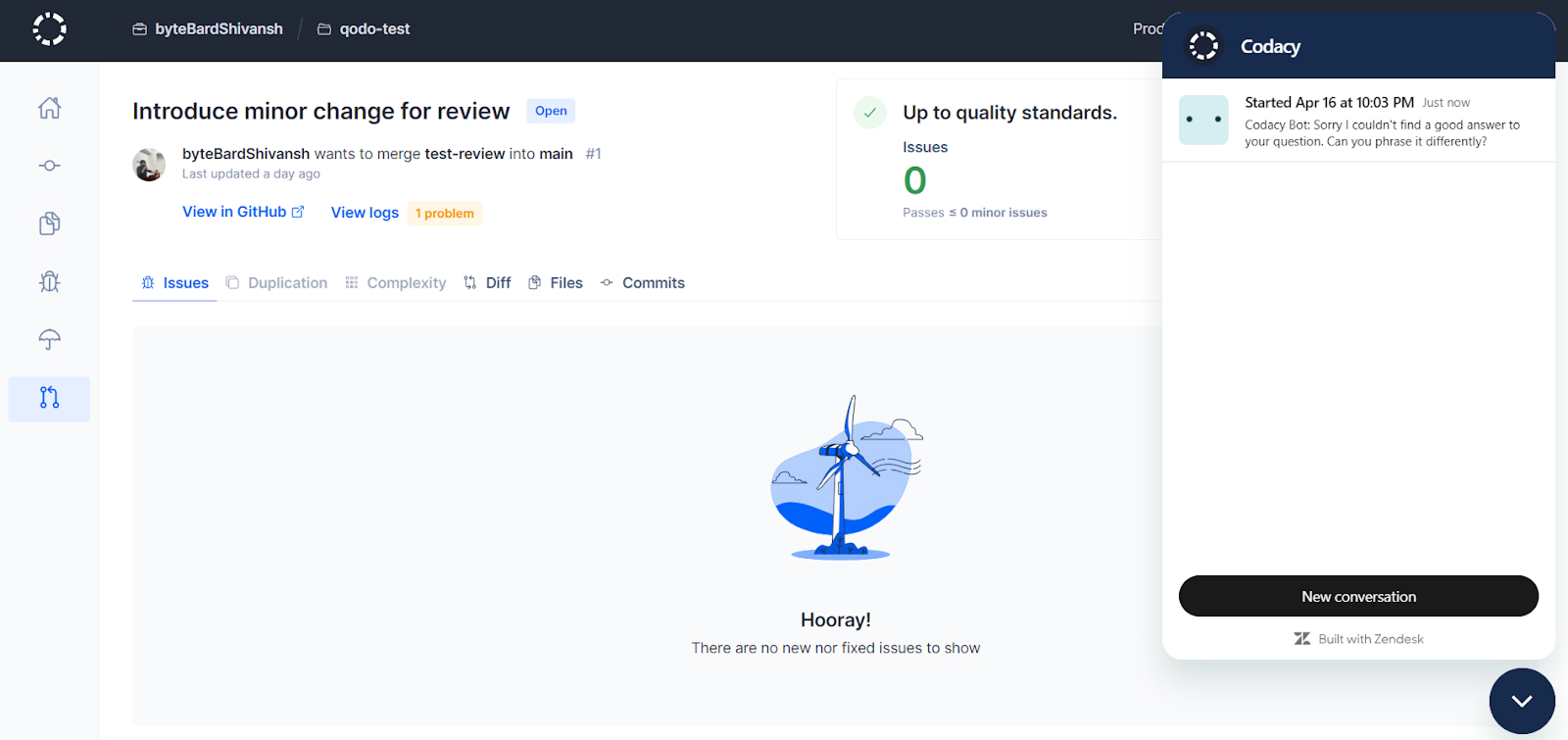
Even though the test PR passed with zero unresolved issues, the platform highlighted how it could block merges if any serious issues were found.
However, during this interaction, I noticed that the built-in Codacy Bot didn’t have answers for certain questions, suggesting that its conversational support could use some improvement. Still, this minor hiccup didn’t overshadow its robust features for code quality enforcement.
Pros
- Comprehensive quality checks: Codacy evaluates complexity, duplication, test coverage, and more to maintain consistent code quality.
- Customizable rules: Teams can define quality gates, thresholds, and enforcement rules to match their specific needs.
- CI/CD-friendly: Easily integrates into CI/CD pipelines to catch issues before they reach production.
Cons
- Limited conversational support: The built-in bot may struggle with complex questions, which can slow down troubleshooting.
- Setup complexity: Tailoring rules and thresholds takes some initial effort to get right for your team.
Pricing
Codacy has a free plan for individuals and small teams, with the Team plans starting at $21/month. Custom Business plans are also available on their website.
5. Devlo.ai

Next on the list of automated code reviews tools, we have Devlo.ai. I put this tool in my list because I liked how it went beyond surface-level issues that LLMs cannot.
Instead of waiting for feedback from a senior developer, Devlo acts like one, providing suggestions that reflect deep context awareness. It automatically breaks down what’s missing in a PR, flags brittle logic, and offers recommendations to fix or improve it.
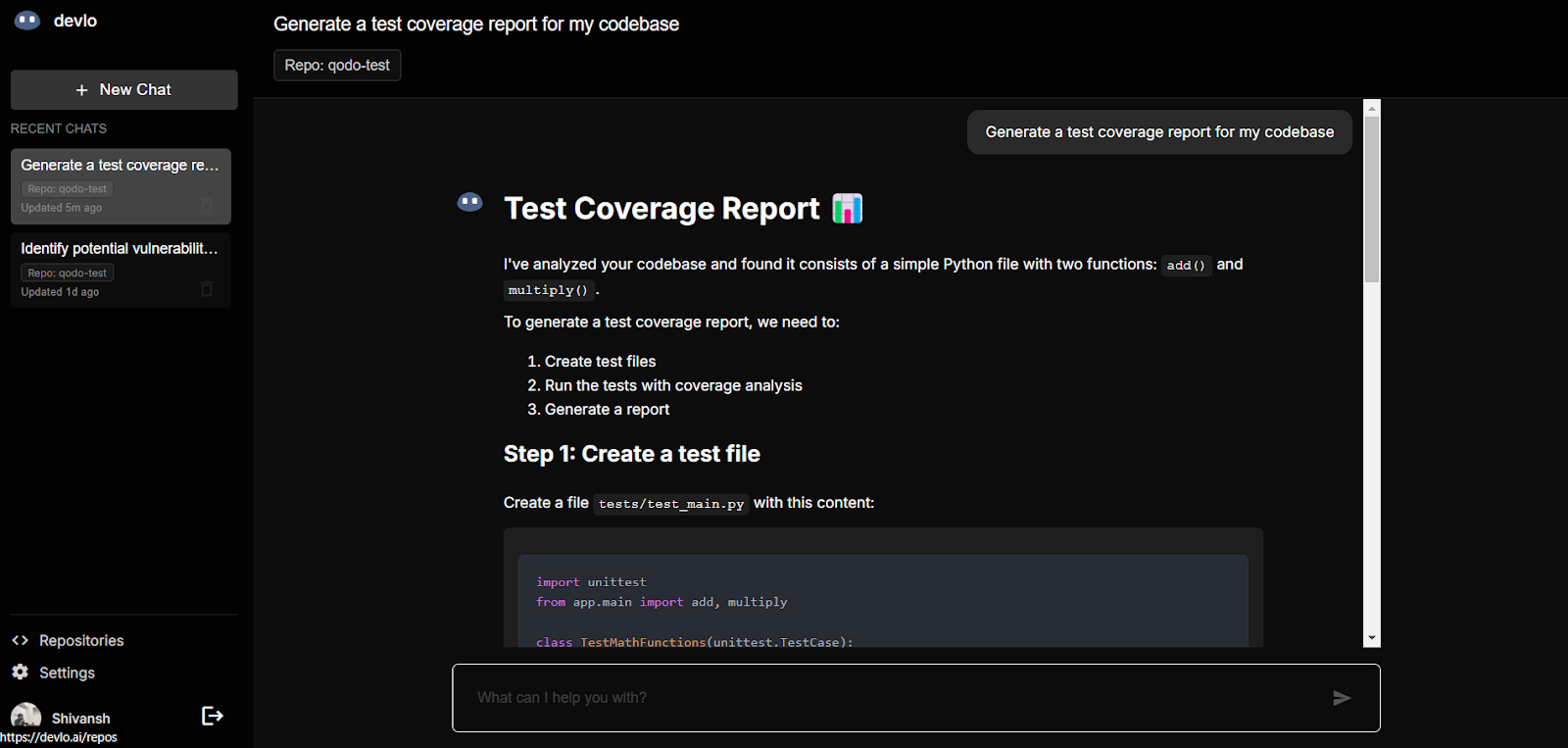
My Experience with Devlo.ai
During a recent project, I used Devlo.ai to review a repository I was working on. It flagged potential performance issues and identified missing test coverage for two core functions: add() and multiply(). Devlo went further by generating a full test coverage workflow, including a unit test script, and even provided detailed CLI steps to run coverage analysis.
Though it helped with linting, it also helped me ensure that the code was fully tested and robust. It gave me a clear view of what was missing in the PR and offered actionable suggestions, which saved me time and effort in identifying potential pitfalls.
Well, I can say that along with highlighting bugs, it identifies logical gaps or performance risks, which you might miss in the rush of fast-paced development, which is great for production level codes.
Pros
- Proactive test generation: Automatically creates unit tests and runs coverage analysis, helping ensure your code is well-tested and reliable.
- Deep context awareness: Checks for logical issues, performance problems, and security risks, aligning feedback with best practices.
- Reduces cognitive load: Lets developers focus on what matters most by catching hidden issues like brittle logic or missed test cases.
Cons
- Learning curve for advanced features: Custom rules and security audits take a bit of setup and familiarity.
- Limited support for non-standard frameworks: It works best with popular stacks; niche technologies may need extra integration effort.
Pricing
Devlo.ai has a free tier with core features. Paid plans start at Pro plan which is $39month with 4500 credits, Pull requests, etc. It also has a Startup plan at $199/month for team management and advanced reporting features.
6. DeepSource
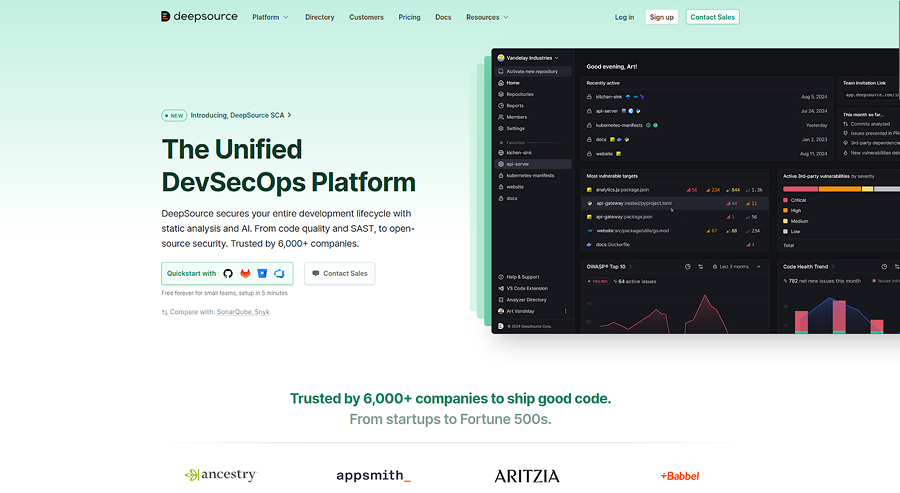
I’ve been using DeepSource for a while now, and it’s really helped understand continuous code health without spending too much time on minor issues. What I really appreciate about it is how it focuses on preventing technical debt before it even becomes an issue.
But what I really like is its autofix capability, instead of just flagging issues, it lets me resolve them with a simple click.
My Experience with DeepSource
When I was working on the qodo-test repository, DeepSource flagged things like:
- Style violations (e.g., missing blank lines or EOF newlines)
- Documentation gaps (e.g., missing docstrings)
While none are critical, DeepSource surfaces them early, allowing for automated cleanup. Teams can track these over time to ensure that standards are enforced and improved.
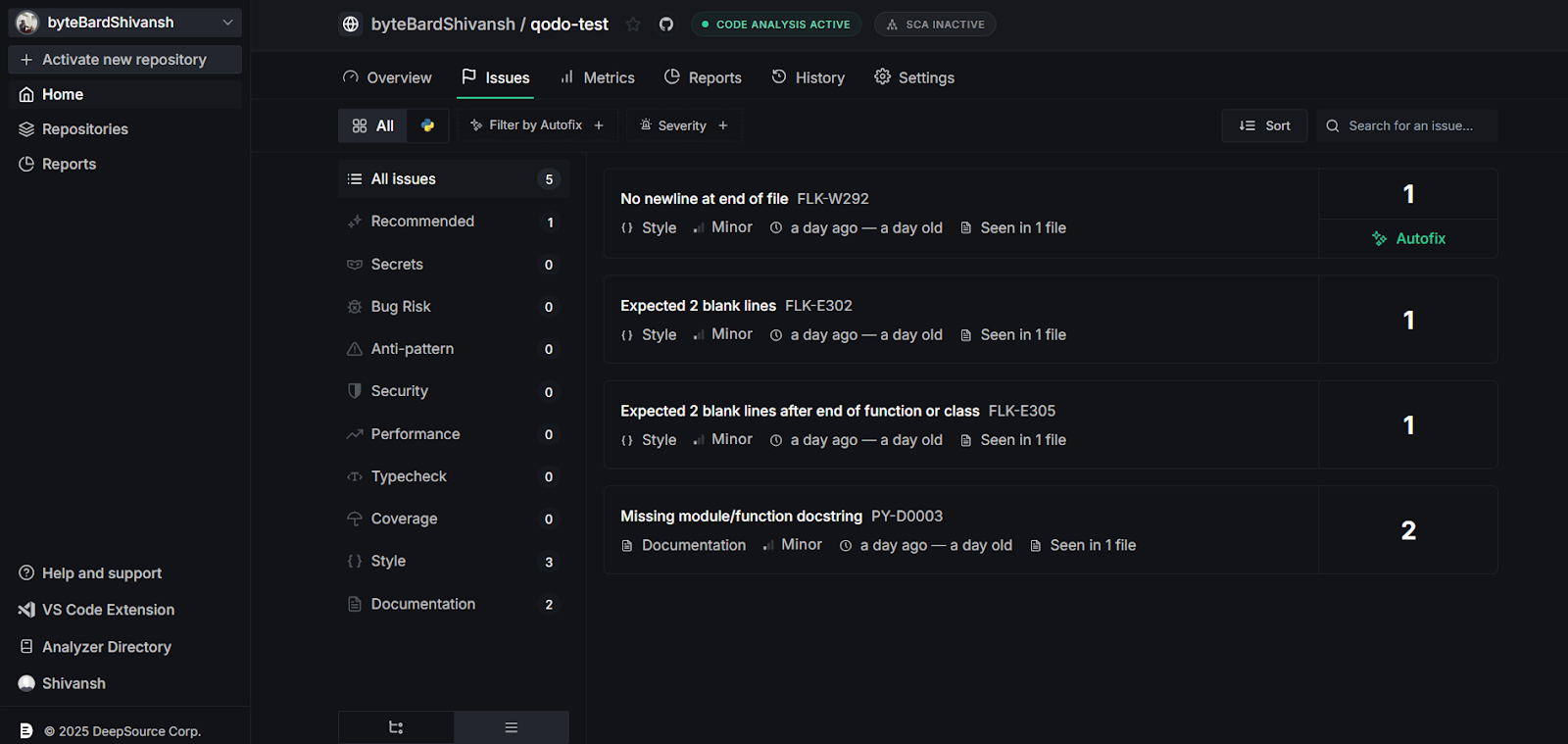
Along with highlighting the issue, it also gave a “Fix button” to automatically resolve them. This saved me the trouble of manually fixing these small problems and kept my code looking clean.
Another feature I’ve found useful is its ability to track the health of the codebase over time. It helps me spot trends in code quality, so I can address recurring problems before they become bigger issues.
Pros
- Autofix capability: The one-click fix saves time when dealing with minor style and documentation issues.
- Long-term code health tracking: Track and monitor the codebase’s quality over weeks or sprints.
- Consistency enforcement: DeepSource helps maintain consistency, which is important as projects scale.
Cons
- Limited depth for complex issues: It’s great for style and documentation, but doesn’t dive deep into more complex logic issues.
- Initial setup can take time: Getting DeepSource to align with your team’s specific rules and preferences takes some configuration.
Pricing
DeepSource offers a free plan for individual developers or small projects. The Starter plan is priced at $8/seat/month. For advanced features, the paid Business plans start at $24/user/month.
7. Korbit.ai
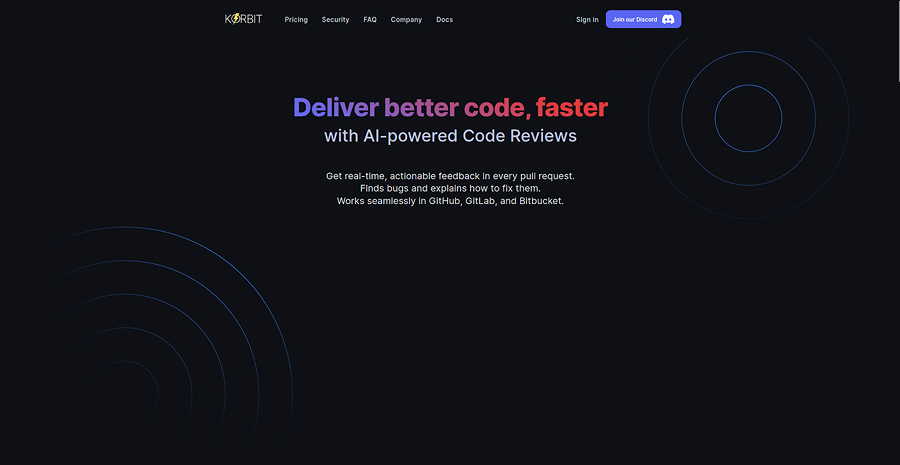
I recently started using Korbit.ai, and it’s been really helpful in terms of simplifying the code review process. It integrates with both GitHub and Bitbucket, automatically scanning my pull requests for a range of critical issues like bugs, performance bottlenecks, and security vulnerabilities.
Above all, one feature that I really appreciate is that it provides actionable feedback right in the pull request, giving me clear suggestions on what to improve.
My Experience with Korbit.ai:
One of the first things I noticed about Korbit.ai was how it automatically scans for issues that would typically take me a while to identify manually. For example, in one of my recent PRs, it flagged a performance lag that I wouldn’t have caught without its help. Korbit did point out the issue but also suggested a better approach to optimize the code, making it feel like I had a mentor reviewing my work.
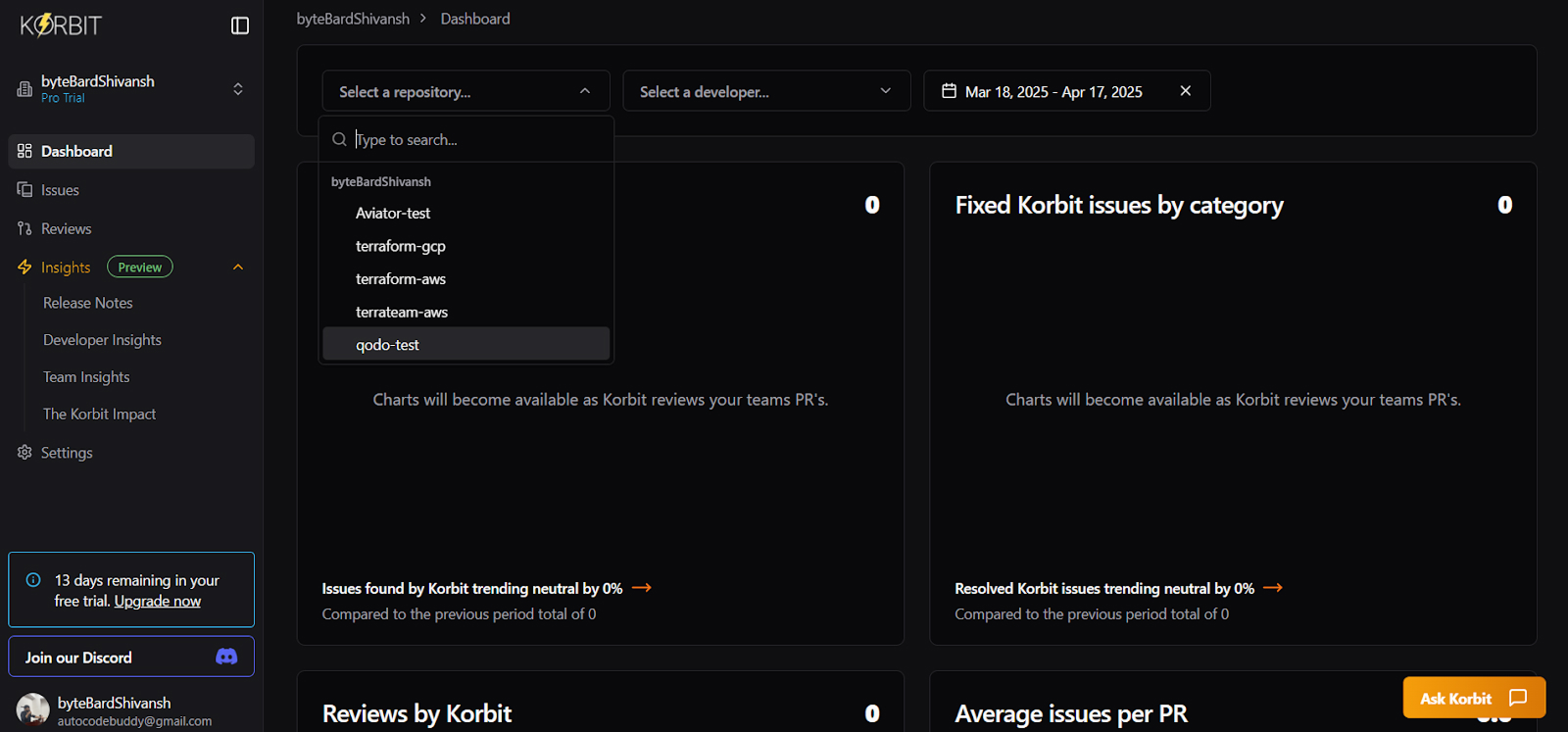
Plus, the Mentor dashboard has also been pretty useful. It tracks key metrics like the number of issues found and fixed over time, helping me and my team see how our code quality evolves. It’s also given me insights into my team’s performance, which has helped in making more informed decisions during project planning.
Pros
- Automated, context-aware reviews: Scans PRs for a range of issues and provides clear, actionable feedback.
- Mentor dashboard: Tracks issues over time and provides insights for project planning and team performance.
- Upskilling opportunities: Gives exercises and suggestions to improve my coding practices.
Cons
- Limited scope for deeper issues: While it’s great for spotting common problems, I found it less effective when dealing with more complex logical issues.
- Free trial limitations: The full potential of Korbit.ai becomes clearer when you move beyond the free trial, which might be a barrier for some teams.
Pricing
Korbit.ai offers a free trial, but to access all its features, including the Mentor dashboard and detailed insights. The Pro plan is for $9/user that has everything in the Starter plan plus unlimited PR reviews and PR descriptions and much more.
Standalone & Open-Source Automated Code Review Tools
For regulated setups and enterprise environments, having tight control and the ability to customize your code review process is essential. These tools integrate directly with your source control and CI systems, ensuring that the review process meets strict internal standards and compliance requirements.
8. Gerrit
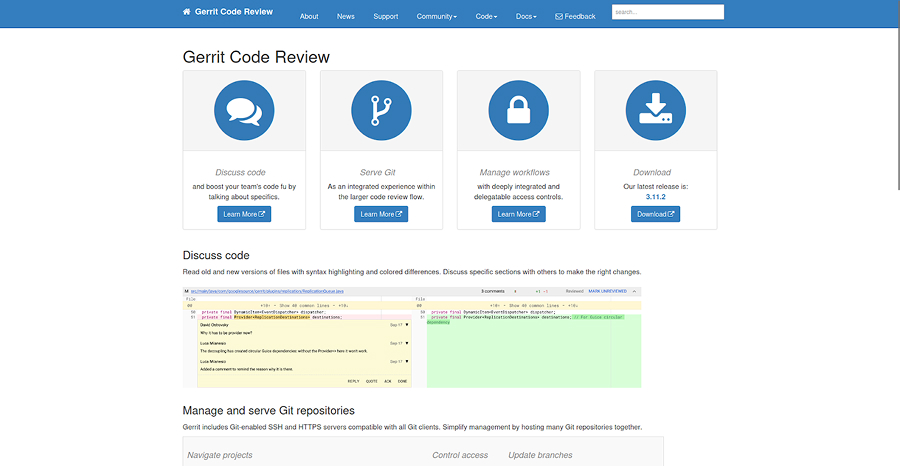
I recently got my hands on Gerrit, a web-based automated code review system built specifically for teams who need a structured, auditable, and controlled review process. Gerrit is designed to ensure that only fully reviewed and approved changes make it into shared branches by enforcing strict review gates.
My Experience with Gerrit
The first thing I noticed was how easy it was to integrate with GitHub. GerritHub allows you to replicate your GitHub repository directly into Gerrit, which saves a lot of setup time. After replicating my qodo-test repository, it was ready for review within Gerrit’s interface, where all open pull requests automatically appear under the “Opened Pull Requests” tab.
In my hands-on test, I reviewed a pull request titled “Introduce minor change for review.”
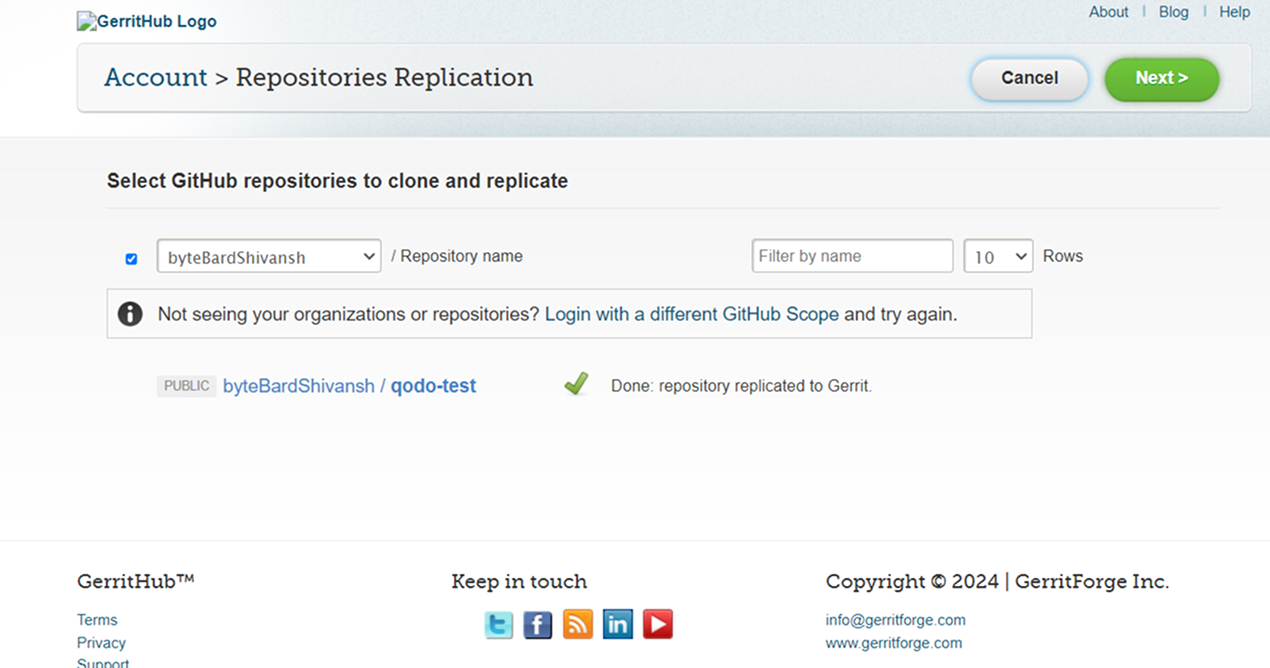
The PR was well-structured with clear headings like Description, Changes walkthrough, and “Need help?”, which made it super easy to understand the context and review the changes. The change involved fixing a logic bug in the add() function, and the PR came with a summary message explaining the fix, making it easy to see what was done and why.
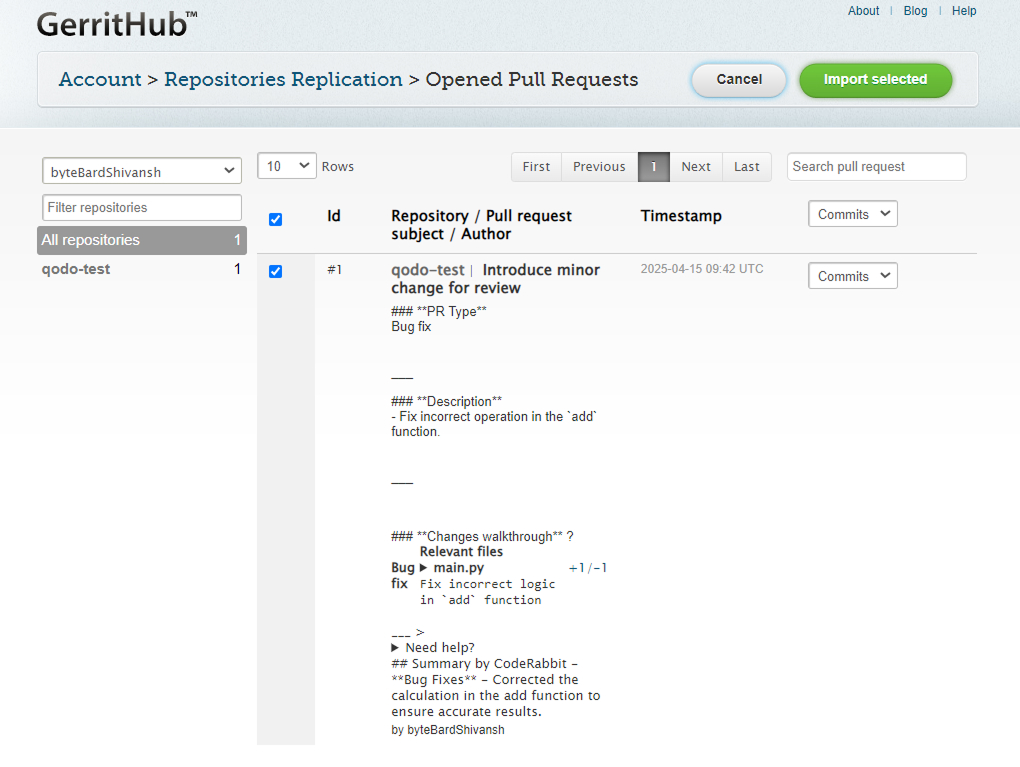
Once I opened the review, I really liked the side-by-side diff view. On the left was the original code, and on the right was the updated version. This layout gave me full context for each change, allowing for precise inline commenting.
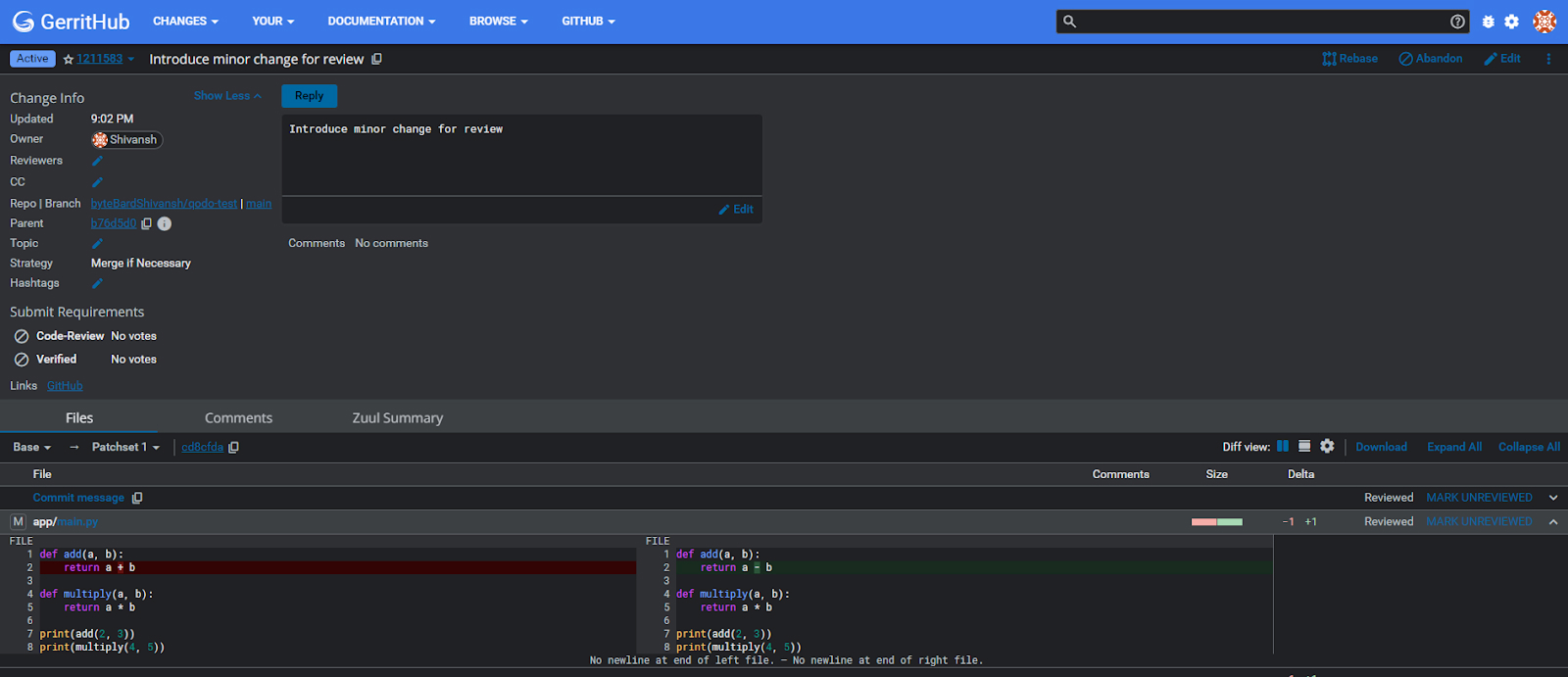
Plus, the tool uses a strict review workflow with group-based permissions, meaning only authorized contributors can approve or submit changes. That means the review process is always compliant and traceable!
Pros
- Side-by-side diff view for easy code comparison.
- Auditable and traceable actions, perfect for compliance needs.
- Structured and controlled review workflows to enforce high review standards.
- Group-based permissions to ensure only authorized reviewers can approve changes.
Cons
- Initial setup might be a bit tedious for teams unfamiliar with Gerrit.
- Steep learning curve: It may take some time for new users to get comfortable with Gerrit’s interface and workflows.
Pricing
It’s open-source so it’s free if you’re using it yourself. For private repositories, paid plans typically start at around $1522/month for 100 users, with enterprise options available for larger teams.
9. PullApprove
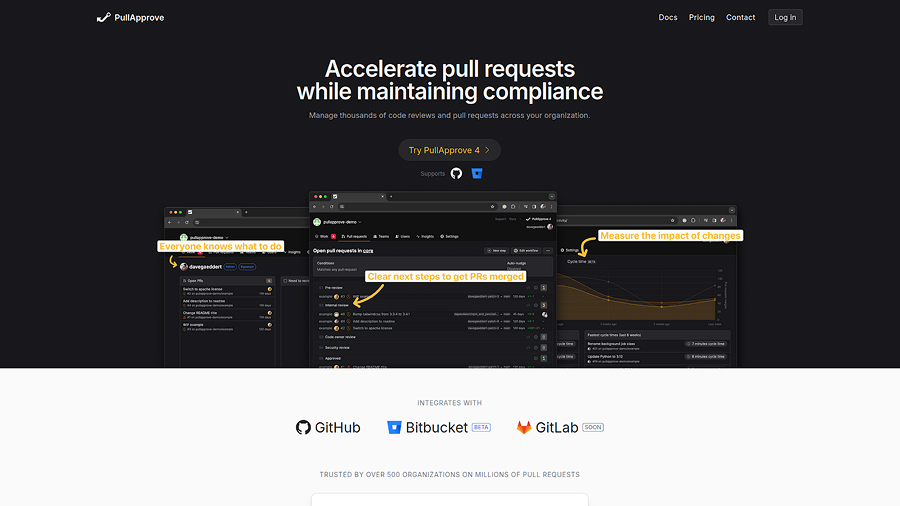
PullApprove is a flexible, lightweight code review automation tool that integrates directly with GitHub. It allows teams to define custom approval rules, giving them full control over who approves pull requests, under what conditions, and how reviews should be routed across different branches or files.
My Experience with PullApprove
During testing, I connected a live GitHub repository through the PullApprove interface. The dashboard immediately listed all available repositories, making it easy to activate review logic for each one.
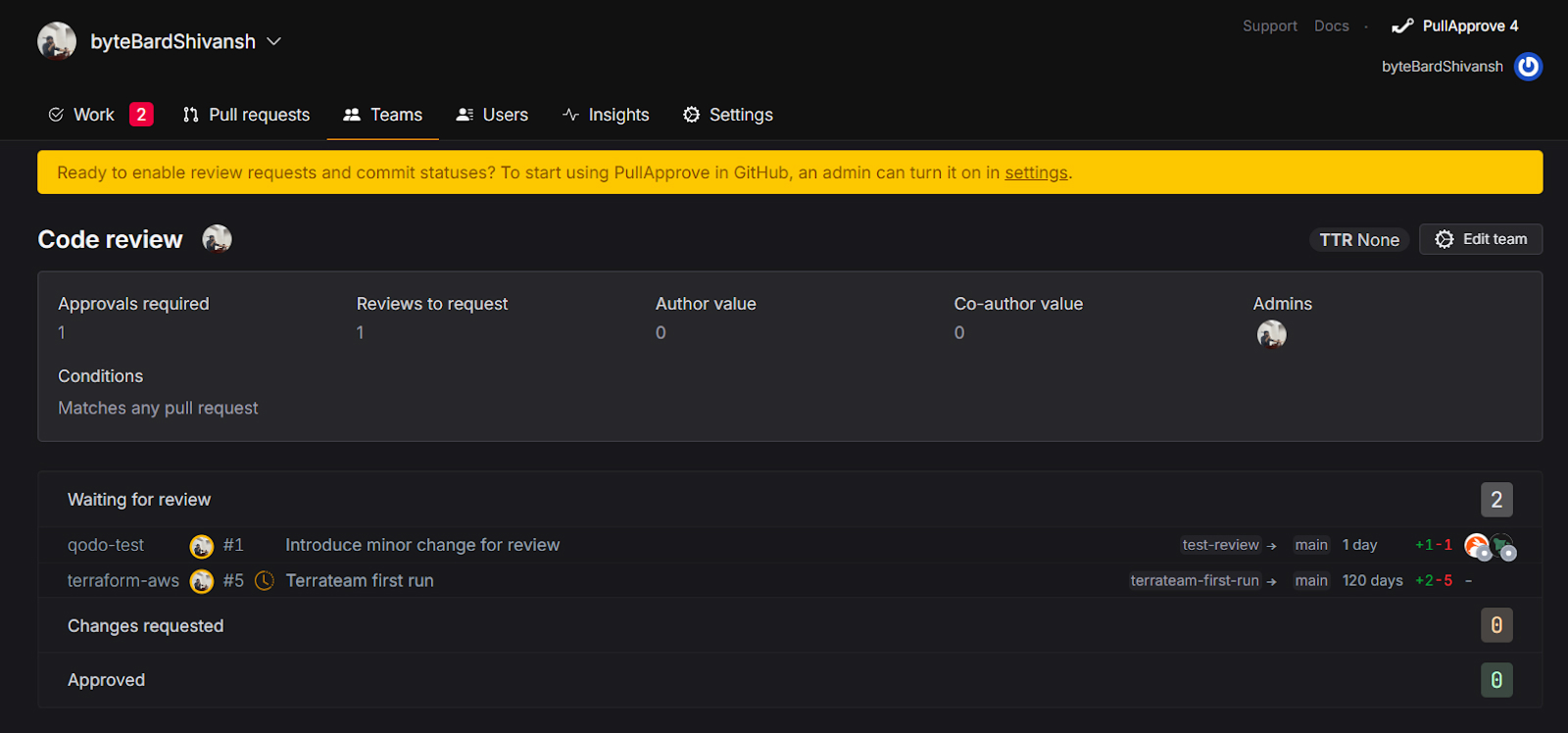
Using a YAML configuration file, I set up specific rules, such as requiring frontend team reviews for changes in src/ui/, or skipping checks on hotfix/* branches. The editor was simple to use and allowed me to version-control the approval logic alongside the code.
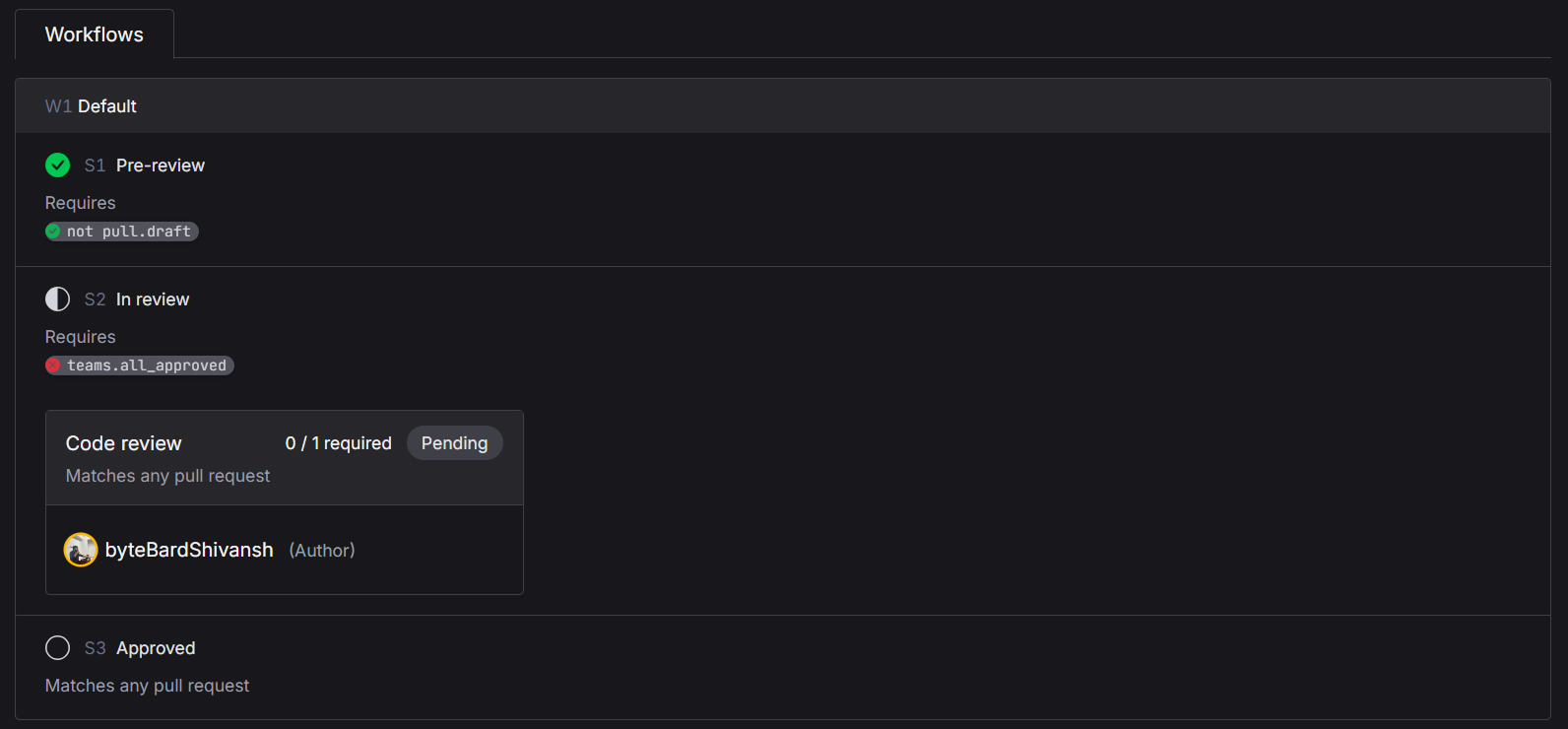
After pushing a PR, PullApprove worked in real time, applying the rules from the YAML file to the pull request. The interface clearly showed which checks passed, which were still pending, and which reviewers were blocking the merge, making the review process completely transparent.
Pros
- Customizable review rules using YAML.
- Clear, real-time tracking of approvals and checks.
- Easy to set up and version-control review logic.
Cons
- Limited to GitHub.
- Might require familiarity with YAML for optimal use.
Pricing
Open-source projects with no paid contributors can use it for free. Others, starts at $5/user/month for small teams, with advanced plans for Organizations ($7/month per user) and enterprises.
Using Qodo Merge Pro
Qodo Merge 1.0 is one of Qodo’s standout tools. It works as a Git-integrated pull request assistant that goes beyond basic linting or static checks. Instead of simply pointing out surface-level issues, it reads into code behavior, change intent, and file history.
It auto-generates concise PR titles and summaries, links issues, detects regressions with context, and flags incomplete or risky changes. The feedback is focused and relevant, helping teams maintain quality without overloading reviewers.
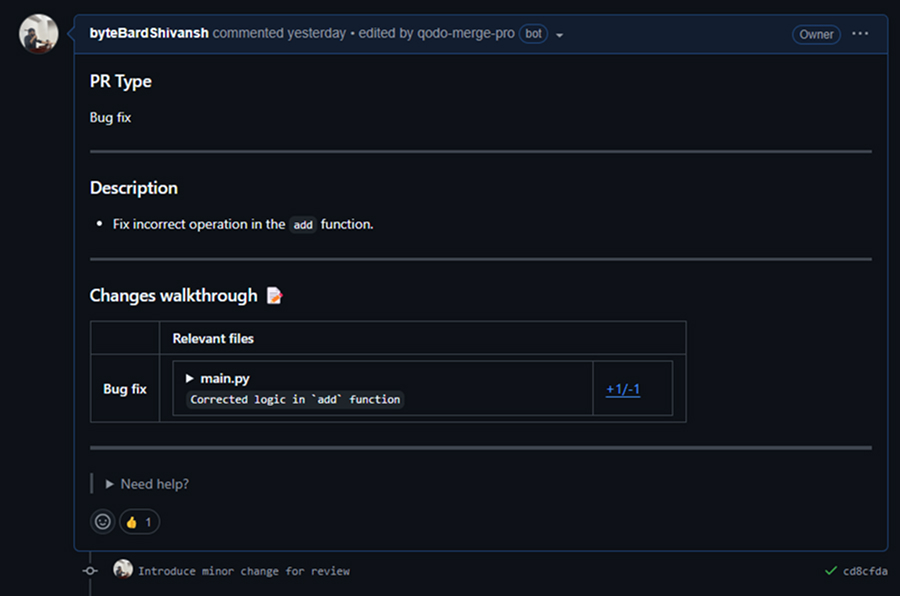
To evaluate it, we tested Qodo Merge Pro on a live pull request inside a test repository: qodo-test/pull/1. The repo wasn’t overly polished or artificially structured. It reflected what a typical mid-sized team would commit to in day-to-day development.
Right from the start, Qodo Merge Pro generated a structured summary that captured not just what changed, but why it changed. It highlighted the affected areas, mentioned missing test coverage, and added context-aware comments where the logic needed better assertions. This level of context reduced ambiguity and made it easier for reviewers to focus on the important parts of the diff.
During the review, Qodo flagged a missing test in a conditional block that looked fine at a glance. It also suggested reworking a hardcoded value into a configurable parameter. These weren’t generic recommendations; they were tailored to the intent and structure of the code. The review felt more like pair programming than static analysis.
Over time, the results start to compound. Review cycles speed up, staging becomes more stable, and developers spend less time clarifying PRs. In our short test cycle, the clarity and precision of suggestions made it clear how this could scale across larger teams and codebases.
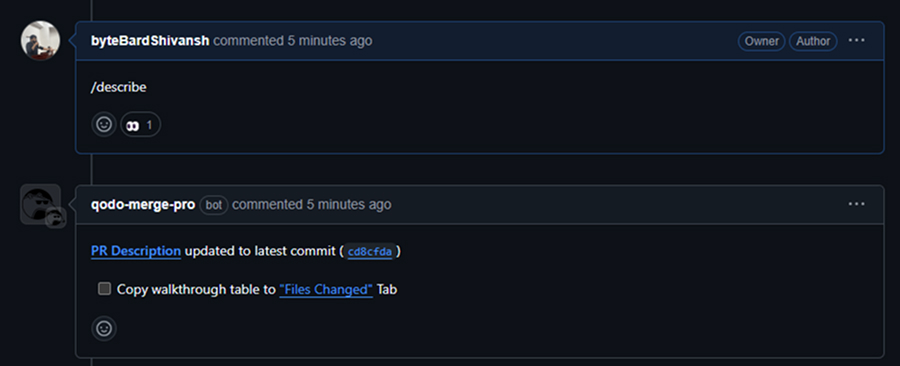
Qodo Merge Pro isn’t just helping teams ship faster. It is enforcing code integrity at every step, using curated context, embedded best practices, and continuous analysis. The outcome is better code, cleaner reviews, and more confidence in every release.
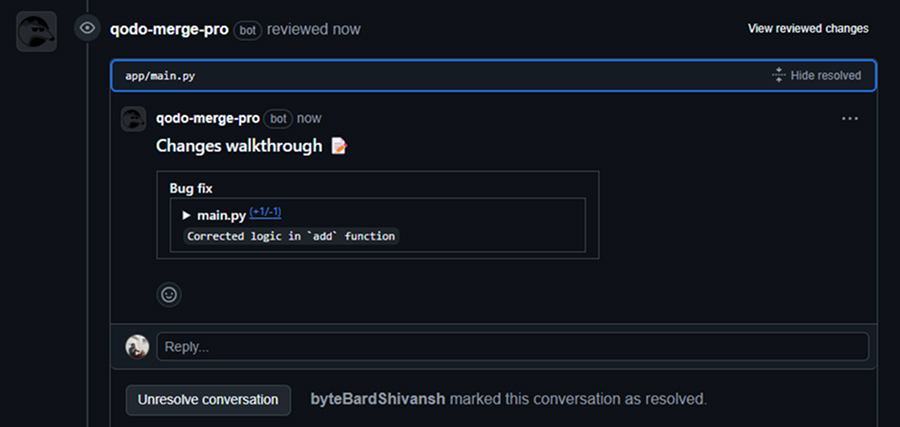
Conclusion
Code reviews are a critical part of maintaining code quality, but they don’t have to be a bottleneck. When done right, they help teams catch bugs, improve design, and ensure consistency – but that can only happen if the review process itself is efficient, insightful, and context-aware.
AI-driven tools like Qodo, CodeRabbit, and Greptile are transforming the landscape by automating repetitive checks and providing deeper insights, but they’re not replacing human judgment. Instead, they’re enhancing it. By getting to know your codebase, spotting the bigger issues, and helping developers zero in on what really matters, these tools make reviews faster and more impactful.
Traditional systems like Gerrit and Crucible still have a place, especially for teams with strict compliance needs, but the future is moving toward smarter, faster, and more collaborative reviews. The key is finding the tool that fits your team’s unique needs – one that can integrate seamlessly into your existing workflow, support your scale, and improve team morale.
In the end, the right automated code review tools don’t just catch bugs; it accelerates your team’s ability to ship high-quality software, confidently and efficiently.
FAQs
1. What is Automated Code Review, and How Does It Work?
Automated code review uses tools and AI-driven systems to automatically analyze and review code for issues such as bugs, performance problems, and adherence to coding standards.
2. How Does Automated Code Review Improve Developer Productivity?
Automated code review tools catch common issues early, so developers can focus on the harder stuff. They handle repetitive tasks like formatting and simple errors, saving time and keeping the workflow smooth.
3. Can Automated Code Review Tools Replace Human Reviewers?
Automated code review tools are great for speeding things up and catching surface-level issues, but they’re no substitute for human reviewers. They offer helpful suggestions, but you still need human judgment for deeper logic, design decisions, and aligning with project goals.
4. What Are the Benefits of Using Automated Code Review Tools in Large Teams?
For large teams, automated code review tools offer a scalable way to keep code quality in check. They streamline reviews with context-aware feedback, flag issues early, and reduce slowdowns, leading to faster feedback, smoother collaboration, and more consistent coding standards.
